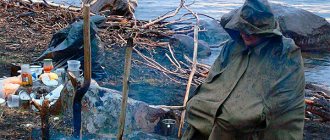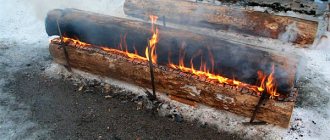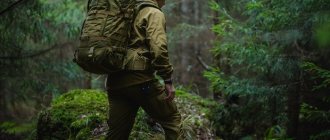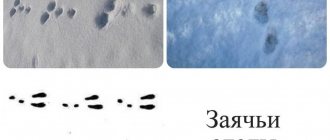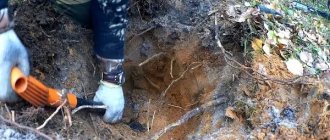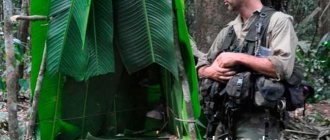Where is the best place to make a fire?
No matter what time of year a tourist gets into the forest, it is prohibited to light a fire in the immediate vicinity of coniferous trees. In the summer, the branches can catch fire, and in the winter, snow accumulates on them, which will fall from a gust of wind and extinguish the fire in the winter forest. The recreational tent should also be located away from the fire to prevent the tent from igniting from flying sparks.
Before starting a fire, you should prepare the area. To do this, you need to clear the snow, which will begin to melt due to the temperature and flood the fire. At the same time, you should clear the area for the fire pit and the area for your own rest.
If the snow cover is deep enough and it is not possible to clear the fire pit right down to the ground, then you need to find large-diameter logs and make a deck from them. It’s great if a tourist plans a winter trip in advance and takes with him a metal mesh on which to lay the flooring to start a fire. This grid helps maintain a fire even if there is a high level of snowdrifts in the forest.
Firewood harvesting
Dry firewood is the key to a successful winter fire. As firewood, you can use dead wood that lacks bark (this is one of the indicators of wood dryness). Dry coniferous trees burn very well (it is better to look for pine, as it contains less resin). During your search, you should carefully inspect the tree for the presence of green needles. If they are, then the wood is not suitable for lighting a fire.
It is also necessary to evaluate the thickness of the dead wood found to determine the cost of physical strength to obtain firewood from it. And, of course, it is important to follow safety precautions when felling a tree.
Preparing firewood for a fire in winter
How to light a fire in the forest in winter
Birch bark is considered the best material for lighting a winter fire. Material with a thinner thickness flares up better. It is necessary to lay thin and dry brushwood on the birch bark. It is worth looking on coniferous trees. It is worth leaving a small supply of birch bark in case you fail to get a fire on the first try or the fire goes out due to weather conditions. If birch bark and brushwood are not at hand, then use a knife to chop wood chips. A “hut” fire is considered an ideal option in calm weather. Thick firewood is placed in a criss-cross pattern above the ignition and tinder. This type of fire will provide a large amount of heat and light, and will also quickly burn down to embers.
When adding wood to the fire, you should remember the main principle of lighting a fire - small branches burn first, and only then can you use larger diameter wood, stumps and other wood for burning. Large firewood should be spaced apart and oxygen supplied for better combustion in adverse weather conditions.
Lighting a fire in winter
How to light a fire in the forest in winter without harming nature
Green tourism has become very fashionable in modern society. But not all new tourists even know the basics of fire safety in nature. Without thinking about the consequences, they build a fire for cooking under trees, near bushes, and do not monitor it.
Bonfire
Fire in the forest is often vital: it warms, dries clothes, makes it possible to drink tea and cook. But you need to know the rules for handling it, have basic practical skills in breeding and extinguishing, and understand the types and methods of its decomposition.
Types of fire:
hut (in the form of a house with kindling inside) is convenient for cooking, night lighting, and requires little firewood;
a well (in the form of a wooden frame, square, kindling inside) is suitable for cooking, has a wide, low flame;
star (thick branches folded crosswise) is suitable for a night fire, does not require continuous attention, it is enough to move the logs towards the center;
taiga (a powerful fire made of thick logs stacked on top of each other with a lining of wood chips) burns well for up to 10 hours, heats up, scares away animals;
hunting (three medium logs on a lining), burns for up to 8 hours, does not require special supervision;
Polynesian (or pit) - the safest fire, produces a lot of ash, economical;
a node (of 3 thick and long logs lying in the letter H) gives a lot of heat, which is regulated by moving the logs.
Any mistake when setting up a fire can destroy the ecological balance. For example, the heat of a fire near trees will greatly heat their bark and living tissue. The tree may die. Soil heated to high temperatures bakes and becomes lifeless.
There are a number of rules for a “safe fire”:
remove all flammable objects from the fire at a distance of more than half a meter;
For emergency fire extinguishing, keep several containers of water nearby;
place a bunch of chopped branches nearby to smother the fire;
never light a fire near resinous trees, near trees with hollows, or in old clearings;
dense grass, moss, and lichen can cause fires in surrounding trees;
do not build high and large fires: several small ones can bring you more benefit;
if you see an old fireplace, use it;
If you do not find a suitable place, remove the top layer of soil with turf and light a fire on the ground without an organic substrate.
Don’t forget: if you are in a protected forest, there will definitely be a fire pit. Unauthorized transfer of it is punishable by law.
Useful tips
In winter, there is often a desire to warm the insides of the tent by placing the tent close to the fire. But never do this, as sparks from the fire will burn through the expensive tent and ruin a good, expensive tent. It is best to place the fireplace on the side where the wind blows, so that the wind drives the smoke away from the tents. Don't worry, the heat won't escape from the fire with smoke. Most of the heat enters the tent due to the spread of infrared radiation.
Prepare a small piece of polyethylene or a rag that will serve as a mat inside the tent. Snow that gets into the tent on your feet freezes and sticks to the bottom from the inside, and is not so easy to get rid of. If you want to keep your boots warm, pack them in a plastic bag and put them in your sleeping bag.
If you were careless and a fire did occur, do not waste a minute. Immediately call the rescue phone number about the location of the fire and begin to eliminate the fire.
In the event of a fire, call:
– “01, 101” – a single telephone number for firefighters and rescuers for dialing from all landlines;
– “010, 101” – a single telephone number for firefighters and rescuers for users of the MTS and Megafon mobile networks;
– “001, 101” – a single telephone number for firefighters and rescuers for Beeline network users;
– “112” – a single emergency number for dialing from all mobile operators and landline phones.
LLC "Mogoktak"
How to make fire without matches
Once the fire pit is prepared, you can start getting the fire going. To do this, you will need to find all the necessary blanks. This list includes:
- dry bark, moss, reeds - tinder;
- thin branches, dry leaves - kindling;
- dead wood to support combustion.
You can use an anthill to search for kindling and tinder. If you remove a little layer of the surface, you can easily find a small amount of the necessary material inside. An alternative option is wood chips, which can be cut from the middle of thick logs. Kindling is the basis of a fire and should be lit first.
A can of perfume or other alcohol-containing liquid will be an excellent assistant when starting a fire in a winter forest. The spray will speed up the kindling process, and at the initial stage will maximize the temperature of the fire.
If the tourist has specialized tools for igniting a flame, for example, a lighter or matches, there is no need to play Robinson and make fire using any intricate method. Only in the absence of the benefits of civilization can you use one of the following methods of lighting a fire. It is important to understand that you should not choose the most exotic option, but the method that requires the least amount of physical strength and skills.
Using a lens or magnifying glass
Often in sunny weather, in the courtyard of a house, you can meet children who, using a magnifying glass, burn some hieroglyphs onto a wooden surface. No matter how strange it may seem, it is precisely this kind of activity that instills one of the most important skills in obtaining fire. The only difference will be that instead of a wooden surface, tinder is used in the forest.
If the tourist does not have a magnifying glass with him, then a lens from binoculars or glasses can be used to get fire. If such items are not available, then you can light a fire using a transparent plastic bag filled with water. As an alternative in winter, you can use a piece of ice. It should be remembered that such a process takes a lot of time and it is better to be patient.
Making fire with a lens
As soon as smoke starts coming from the kindling, you can add dry brushwood and thin firewood in small portions.
Using manganese
You can also get a fire using pharmaceutical potassium permanganate. It is important to remember that working with potassium permanganate requires compliance with safety precautions, since when interacting with other substances described below, a chemical reaction occurs. To start a fire, use one of the following methods:
- Potassium permanganate and ordinary crystalline sugar are mixed in a ratio of 9:1. Dry flammable material, such as grass or cotton wool, is laid out on the prepared area. The tinder is sprinkled with the resulting mixture and the stick is placed at an angle of 45 degrees. With its help, potassium permanganate is rubbed into the tinder, and it ignites. Then all that remains is to catch the moment the combustion begins and add brushwood and kindling to the future fire.
- Potassium permanganate and sugar are mixed in a 4:1 ratio. The resulting mixture is wrapped in a paper bag and placed on the kindling. Now you need to find a large stone and hit it hard on the paper bag. This method of producing fire requires constant practice and may not be possible for every beginner.
- Potassium permanganate and glycerin are mixed. An object made of flammable material is placed on the tinder, potassium permanganate is poured in and a few drops of glycerin are added. The moment glycerin contacts manganese, a small amount of smoke begins to be released and a sudden fire begins.
- If a tourist comes to the winter forest by car, then he should have antifreeze or antifreeze with him. Pour a spoonful of potassium permanganate onto a paper sheet and add a few drops of liquid. The paper is rolled tightly and placed on the kindling. After a few minutes, the mixture in the bag will spontaneously ignite.
Lighting a fire
Using friction force
This option for producing fire is considered the most energy-consuming and complex. To light a fire, you need to equip yourself with three basic elements:
- a wooden board or stump, in which you will have to cut a hole in the middle, the diameter of which will be identical to the size of the stick;
- with a stick at least 30 centimeters long. It is necessary to sharpen one end so that the ignition tool visually resembles a pencil;
- a branch of small diameter (it is best to look for a birch branch) and no more than a meter long. A rope should be tied to it in such a way that the resulting object resembles an Indian bow.
Then tinder is poured into the prepared hole of the first element. Next, the sharp end of the stick is inserted into the hole, and the bow string is placed on top. After which you need to start moving the bow back and forth.
As soon as the flame appears, you can throw in brushwood. It is important to remember to take precautions and wrap your palms in a rag or wear gloves to avoid getting calluses.
Making fire by friction
Using flint
In this option, it is important to find several medium-sized hard stones nearby that will act as flint. A steel object is placed on the tinder (you can use a knife blade) and struck with a stone until it ignites. Don't expect quick fire from this method. First of all, smoke should appear and the tourist should fan the fire.
Similarly, you can use two hard stones for ignition, striking each other with glancing blows.
With gunpowder
The easiest to implement and at the same time the most specific option is considered to be using gunpowder. The essence of the method of making fire is that gunpowder is poured onto a stone and tinder, and the incendiary mixture is ground with a second stone until it ignites.
Lighting a fire with flint
Ways to make a fire without matches
So, the place is ready and before starting to build a fire, preparations are needed. So, our preparation will include: kindling - thin twigs, twigs, reeds, dry bark (birch bark is best), grass, moss, dry leaves, bird feathers, at worst, paper, fabric (if you have it with you) will do. .
If none of the above can be found, an anthill can help. You just need to remove its upper part, which is saturated with moisture, or find a spruce with a dry rag underneath. Another alternative way to obtain kindling is to sharpen thick branches with a knife, because they are dry in the middle, so these chips are ideal for kindling. Kindling serves as the basis of the fire; it is set on fire first.
The second element is something that will directly burn and warm you in winter. This includes dry firewood, thick tree branches, brushwood that is under the snow (it is drier than that that is on the trees).
Alcohol-containing liquids - perfume, alcohol - can also serve as an assistant (if available, of course). Etc. They can be used to moisten kindling or basic supplies for better effect and faster starting of the fire.
When the place and supplies are ready, you can start lighting the fire. As already written above, there is no need to complicate life if you have sources of open fire (lighter, matches, etc.), but we will look at what to do in the absence of these benefits of civilization. Here everything will depend on what you have available and which method will be less energy-consuming for you.
Optical method (lens, magnifying glass)
I think many in childhood loved to burn some squiggles onto pieces of wood in sunny weather with a magnifying glass and the sun. Oddly enough, this entertainment developed the first and most important skill of lighting a fire. The only difference is that in our case, kindling is used instead of wood.
If you don’t have a magnifying glass, you can replace it with a lens, glasses, binoculars, etc. And if you don’t have anything suitable at hand, then you can put water in a transparent bag and, in the same way with a magnifying glass, focus the sunlight in one place. A bottle of water or a piece of ice will do the same, with only one difference: in cases without lenses and magnifiers, this procedure takes much longer.
When the kindling begins to smoke and the first flames appear, you can add the main supplies of brushwood and firewood a little at a time.
This is interesting: Choosing and preparing a place for a fire
Chemical method (Manganese)
For this method, you need to look into the first aid kit that you took with you on your hike. The main character in it for us is potassium permanganate, also known as potassium permanganate. It is in almost every first aid kit; we will describe in combination with what elements and in what ways you can achieve results.
The most important thing is to be careful and not forget about the dosage. It also helps to practice, so you can experiment at home, but remember to be careful!
So, the main chem. compounds for starting a fire: potassium permanganate and sugar in a ratio of 9 to 1. Place a flammable material (cotton wool, dry grass, etc.) on a flat surface, sprinkle potassium permanganate and sugar on it, then rub cotton wool with a hard stick at an angle of 45 degrees starts to burn and at this moment we put in kindling and the main supply of brushwood.
Potassium permanganate and sugar in a ratio of 4 to 1. It is necessary to mix sugar and potassium permanganate, then wrap the mixture tightly in paper, place it on the kindling and hit it hard with a stone. It may not work the first time; this method requires practice.
Potassium permanganate and glycerin. Place any flammable object (paper, napkin, etc.) on top of the kindling, add potassium permanganate, and add a couple of drops of glycerin. A little smoke will appear, after which a sudden fire will occur, after which you can add small twigs first, and then the main brushwood.
Also, if you traveled by car and you have antifreeze or antifreeze with you, you can try the following method. Place about a spoonful of potassium permanganate on a sheet of paper and add a couple of drops of antifreeze or antifreeze. Roll the sheet tightly and place it on the kindling, add small twigs on top. After some time, spontaneous combustion will occur, after which the main supply of brushwood can be added.
Physical (friction force)
This method is the most complex and energy-consuming. To bring it to life, you will need three main elements: a simple board or stump with a shallow hole cut out, the diameter of which is approximately equal to the diameter of the stick.
The second element is an ordinary stick approximately 30 cm long, one side of which is sharpened. Visually it resembles a pencil. The third key element is a thin branch (for example, birch) about a meter long and about 3 cm thick. Bend it a little and pull the rope. Visually reminiscent of an Indian bow.
Next, we sequentially assemble the structure: we pour a little kindling into the hole of the first element (twigs, cotton wool, paper, etc.), insert the sharp end of element two (“pencil”) into the same hole, and wrap the string of our “bow” on top. After this, we begin to move the bow back and forth.
This is interesting: DIY alcohol burner
When the flame lights up, you can throw in the main brushwood. The main thing is to first wrap your palms with a rag or tree bark so as not to develop a callus.
Geological (flint or steel)
For this method, you need to look around you, medium-sized hard stones are ideal, this will be our flint. We bring this stone closer to the kindling and hit it on a steel object (for example, a knife blade) to create a spark, wait for the smoke from the kindling and begin to blow lightly into the kindling until a flame forms, after which we add the main brushwood. A similar method can be used to use two stones with a glancing blow.
Other methods (gunpowder)
The simplest, but at the same time specific method (not everyone always has a couple of extra cartridges with them). The essence of the method is very simple: you need to pour gunpowder from a cartridge onto a stone (or if you just have gunpowder, pour it onto a stone) and rub it with another stone until it ignites, then add kindling, and when the fire gets stronger, add the main brushwood.
How to keep a fire going
As it may seem, there are no difficulties in starting and maintaining a fire. The main thing is to throw wood in a timely manner and the fire will not go out even after a day. However, there are several important nuances:
- To light a fire, you should look for branches of coniferous trees, since such natural material ignites much faster. Once the fire is burning fully, you can switch to hardwood. Such firewood produces more heat and burns more slowly.
- To make a dying fire gain strength again, you just need to take a stick and scatter some coals, ensuring a flow of oxygen. It is a mistake to immediately add a new portion of firewood. This can lead to complete attenuation.
- In difficult weather conditions, it is necessary to provide additional protection from wind and precipitation using homemade canopies and barriers. As soon as the elements subside, you can dry your clothes on such devices.
To keep the fire going, spread the coals
Putting out a fire in winter
Putting out a winter fire is much easier than melting it, since there is always a large amount of frozen water at hand in the form of snow.
But there are often cold and snowless winters. And in this case, you should think through options for extinguishing it even before starting a fire.
You can solve the problem by using a stick to move the coals away from each other. This way they will not touch and will go out faster.
If there is no time to wait, then the largest coals can be transferred to the ice of the nearest body of water.
It is much more difficult for an unprepared tourist to light a fire in a winter forest than to do the same actions in the summer. It is important to constantly train your own skills, and only after achieving complete confidence in your own abilities, plan a long trip to the winter forest. If you don’t think about the nuances of such a trip in advance, you can face great difficulties and overshadow all your anticipation of outdoor recreation.
Putting out winter fires
Putting out fires in winter, as opposed to starting fires, is easier, since water is often available right next to the fire site in the form of snow.
However, if snow has not fallen and the low temperature has persisted for several days, you need to think in advance about how to put out the fire, since the water in the lake may be under a thick layer of ice, and the ground with which you could cover the fire may freeze and turn out to be too hard to be prepared in the required quantity.
In such cases, it makes sense to move the coals away from each other and wait until they die out completely. If the situation requires a hurry, you can try to take large coals to a reservoir and leave them on the ice away from the place where people can walk. Nothing will catch fire here from the coals.
To summarize all that has been said, it can be argued that, in general, lighting a fire in the winter is a more difficult task than the same procedure in the summer, and therefore requires preliminary training and consolidation of acquired skills before a person finds himself in the wild. If this is not taken care of in advance, the outcome in some unforeseen cases may be disastrous.
